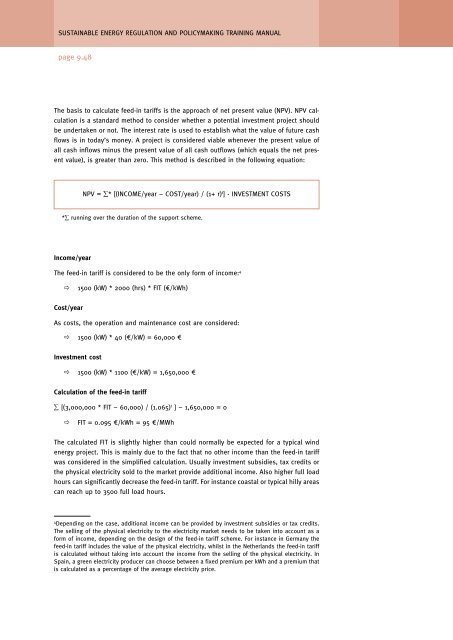Regulatory and policy options to encourage development of ...
Regulatory and policy options to encourage development of ...
Regulatory and policy options to encourage development of ...
- No tags were found...
You also want an ePaper? Increase the reach of your titles
YUMPU automatically turns print PDFs into web optimized ePapers that Google loves.
SUSTAINABLE ENERGY REGULATION AND POLICYMAKING TRAINING MANUALpage 9.48The basis <strong>to</strong> calculate feed-in tariffs is the approach <strong>of</strong> net present value (NPV). NPV calculationis a st<strong>and</strong>ard method <strong>to</strong> consider whether a potential investment project shouldbe undertaken or not. The interest rate is used <strong>to</strong> establish what the value <strong>of</strong> future cashflows is in <strong>to</strong>day’s money. A project is considered viable whenever the present value <strong>of</strong>all cash inflows minus the present value <strong>of</strong> all cash outflows (which equals the net presentvalue), is greater than zero. This method is described in the following equation:NPV = ∑* [(INCOME/year – COST/year) / (1+ r) t ] - INVESTMENT COSTS*∑ running over the duration <strong>of</strong> the support scheme.Income/yearThe feed-in tariff is considered <strong>to</strong> be the only form <strong>of</strong> income: 41500 (kW) * 2000 (hrs) * FIT (€/kWh)Cost/yearAs costs, the operation <strong>and</strong> maintenance cost are considered: 1500 (kW) * 40 (€/kW) = 60,000 €Investment cost 1500 (kW) * 1100 (€/kW) = 1,650,000 €Calculation <strong>of</strong> the feed-in tariff∑ [(3,000,000 * FIT – 60,000) / (1.065) t ] – 1,650,000 = 0FIT = 0.095 €/kWh = 95 €/MWhThe calculated FIT is slightly higher than could normally be expected for a typical windenergy project. This is mainly due <strong>to</strong> the fact that no other income than the feed-in tariffwas considered in the simplified calculation. Usually investment subsidies, tax credits orthe physical electricity sold <strong>to</strong> the market provide additional income. Also higher full loadhours can significantly decrease the feed-in tariff. For instance coastal or typical hilly areascan reach up <strong>to</strong> 3500 full load hours.4Depending on the case, additional income can be provided by investment subsidies or tax credits.The selling <strong>of</strong> the physical electricity <strong>to</strong> the electricity market needs <strong>to</strong> be taken in<strong>to</strong> account as aform <strong>of</strong> income, depending on the design <strong>of</strong> the feed-in tariff scheme. For instance in Germany thefeed-in tariff includes the value <strong>of</strong> the physical electricity, whilst in the Netherl<strong>and</strong>s the feed-in tariffis calculated without taking in<strong>to</strong> account the income from the selling <strong>of</strong> the physical electricity. InSpain, a green electricity producer can choose between a fixed premium per kWh <strong>and</strong> a premium thatis calculated as a percentage <strong>of</strong> the average electricity price.










